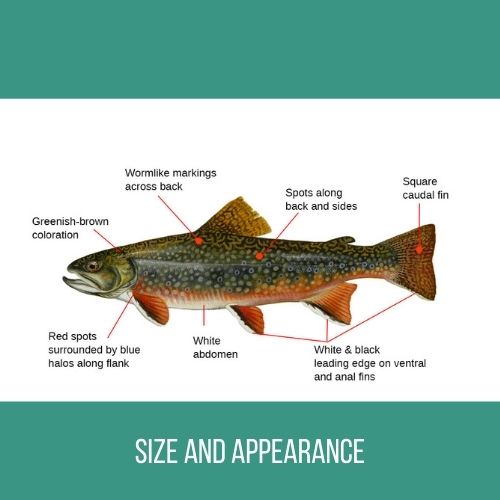Contents
- 1 Do trout have scales:
- 2 Size and appearance:
- 3 Size:
- 4 Body Shape:
- 5 Coloration:
- 6 Scales:
- 7 Fins:
- 8 Scales on Trout:
- 9 1. Structural Composition:
- 10 2. Functionality:
- 11 3. Variability Among Species:
- 12 4. Coloration and Camouflage:
- 13 5. Growth Rings and Age Determination:
- 14 6. Implications for Anglers:
- 15 7. Scientific Research:
- 16 Observations anglers can make related to trout scales:
- 17 Coloration and Luster:
- 18 Scale Condition:
- 19 Scale Patterns:
- 20 Camouflage Effectiveness:
- 21 Growth Rings:
- 22 Spawning Indicators:
- 23 Mucus Layer:
- 24 Scale Loss:
- 25 Finned Areas:
- 26 Overall Body Condition:
- 27 Conclusion:
- 28 FAQs!!
- 29 Q1: Do all trout have scales?
- 30 Q2: What is the purpose of scales on trout?
- 31 Q3: Can you determine a trout’s age by its scales?
- 32 Q4: Do trout scales change color?
- 33 Q5: How can anglers contribute to trout conservation through scale observations?
- 34 Q6: Are there differences in scales among various trout species?
- 35 Q7: What does it mean if a trout has damaged scales?
- 36 Q8: Why is the mucus layer on trout scales important?
- 37 Q9: Can anglers use scale observations to improve their fishing success?
- 38 Q10: Are there any specific considerations for handling trout to preserve their scales?
Yes, trout are a type of fish that do have scales. These scales cover their body and serve as a protective layer.
The trout scales are typically small and overlapping, providing them with a streamlined and hydrodynamic shape for efficient swimming. Let’s dive into do trout have scales.
Do trout have scales:
Trout are freshwater fish belonging to the Salmonidae family, which also includes salmon and char. They are highly prized by anglers for their sporting qualities and are also commercially important for their delicious flesh.
There are various species of trout, with common ones including rainbow trout, brown trout, brook trout, and lake trout.
Typically characterized by a streamlined body, trout are known for their agility and ability to thrive in various aquatic environments, such as rivers, streams, lakes, and ponds.
They play a significant role in ecosystems as both predators and prey, contributing to the overall balance of aquatic ecosystems.

Size and appearance:
The size and appearance of trout can vary among species, but they generally share some common characteristics:

Size:
- Trout sizes can range widely based on the species and environmental factors.
- Some species, like brook trout, are generally smaller, with lengths often ranging from 6 to 18 inches.
- Others, such as lake trout, can grow much larger, sometimes exceeding 30 inches.
Body Shape:
- Trout have a streamlined and fusiform body shape, which helps them navigate swiftly through water.
- Their bodies are designed for speed and efficiency in swimming, enabling them to be effective predators
Coloration:
- The coloration of trout can be quite diverse and is influenced by factors such as habitat and diet.
- Rainbow trout, for instance, exhibit a range of colors, including a pink stripe along their sides, a pinkish hue on their gill covers, and a silvery body.
- Brown trout, on the other hand, often have an olive-brown color with yellowish spots.
Scales:
- Trout are covered with small, overlapping scales that contribute to their protective outer layer.
- These scales can vary in color and may add to the overall appearance of the fish.
Fins:
- Trout have several fins, including dorsal fins, pectoral fins, pelvic fins, anal fins, and a caudal fin.
- The shapes and sizes of these fins are adapted to their swimming habits and environments.
Overall, the size and appearance of trout are influenced by their species, age, and the specific characteristics of the aquatic ecosystems they inhabit.
Scales on Trout:
The scales on trout play a crucial role in their overall anatomy and contribute to various aspects of their survival and behavior. Here’s a closer look at the scales on trout.
1. Structural Composition:
- Dermal Scales: Trout possess dermal scales, which are external bony plates that form a protective layer over their skin.
- Small and Overlapping: These scales are generally small and overlap each other, providing flexibility to the fish’s body while maintaining a protective barrier.
2. Functionality:
- Protection: The primary function of scales is to protect the trout from injuries and parasites. They act as a physical barrier against external threats in the aquatic environment.
- Streamlined Shape: The arrangement of scales contributes to the trout’s streamlined shape, facilitating smooth movement through water.
3. Variability Among Species:
- Size and Pattern: Different species of trout may exhibit variations in scale size, shape, and pattern. These differences can be influenced by genetic factors, environmental conditions, and evolutionary adaptations.
4. Coloration and Camouflage:
- Reflective Properties: Trout scales can have reflective properties that play a role in their coloration. The reflective nature of scales may help in blending with the surrounding environment, providing a form of natural camouflage.
- Adaptation to Habitat: The color and pattern of scales may adapt to the specific habitat in which the trout resides, aiding in both predator avoidance and hunting strategies.
5. Growth Rings and Age Determination:
- Scale Growth Rings: Scales often have growth rings similar to those found in tree trunks. Counting these rings can be a method for estimating the age of a trout, providing valuable information for fisheries management.
6. Implications for Anglers:
- Handling Considerations: Anglers should be mindful of the delicate nature of trout scales. Proper catch-and-release practices help preserve the integrity of these scales, promoting the overall health of fish populations.
- Observation: Anglers can observe the condition and coloration of scales to gain insights into the fish’s well-being, potential stress, or adaptation to its environment.
7. Scientific Research:
- Ecological Studies: Researchers may study trout scales to understand ecological dynamics, migration patterns, and the impact of environmental changes on fish populations.
- Genetic Studies: Examining scale characteristics can contribute to genetic studies, helping scientists distinguish between different populations and species.
- Understanding the importance of scales on trout adds depth to the appreciation of these remarkable freshwater fish and aids in the conservation efforts aimed at preserving their habitats and populations.
Anglers can make several valuable observations related to trout scales during their fishing experiences.
These observations can provide insights into the fish’s health, behavior, and adaptation to its environment.
Here are some key points for anglers to consider:
Coloration and Luster:
Scale Condition:
Vibrancy: The color and luster of the scales can indicate the overall health and vitality of the trout. Bright and vibrant scales are often associated with a healthy fish.
Intact Scales: Observing whether the trout’s scales are intact or damaged can provide information about its recent experiences. Fish with well-preserved scales may have encountered fewer challenges or predators.
Scale Patterns:
Consistency: Consistent and well-defined scale patterns may suggest that the trout is adapting well to its environment. Disruptions in scale patterns could indicate injuries or stress.
Camouflage Effectiveness:
Blending In: Assessing how well the trout’s scales blend with the surrounding environment can give clues about its ability to camouflage. A trout with effective camouflage may be more successful in ambushing prey or avoiding predators.
Growth Rings:
Counting Rings: Examining the growth rings on scales (similar to tree rings) can help estimate the age of the trout. Anglers can use this information to gain insights into the fish population’s age structure.
Spawning Indicators:
Color Changes: During the spawning season, the colors of a trout’s scales might change. Observing these changes can provide information about the fish’s reproductive status and behavior.
Mucus Layer:
Healthy Mucus: A thin, transparent mucus layer covering the scales is normal and healthy. An excessively thick or discolored mucus layer may indicate stress or the presence of diseases.
Scale Loss:
Natural Wear: It’s normal for trout to experience some scale loss over time due to natural wear and tear. However, excessive scale loss may be a sign of poor handling, injuries, or environmental stress.
Finned Areas:
Tail and Dorsal Fin: Observing the condition of the scales around the tail and dorsal fin can provide information about the fish’s recent activities, such as escaping predators or navigating through rocky areas.
Overall Body Condition:
Plumpness: The overall plumpness and condition of the trout’s body, as observed through its scales, can indicate whether it has been feeding well and is in good health.
By paying attention to these observations, anglers can contribute valuable data to fisheries management and enhance their understanding of trout behavior, ecology, and the importance of conservation practices
Conclusion:
In conclusion, observing trout scales provides valuable insights for anglers. The color, condition, and patterns of scales offer clues about the fish’s health, behavior, and adaptation to its environment.
By making these observations, anglers contribute to the broader understanding of trout ecology and aid in conservation efforts, ensuring the well-being of these freshwater species.
FAQs!!
Certainly! Here are some frequently asked questions (FAQs) about trout scales:
Q1: Do all trout have scales?
A1: Yes, all trout have scales. Scales are an essential feature of their anatomy, providing protection and aiding in their ability to move through the water.
Q2: What is the purpose of scales on trout?
A2: The primary purpose of scales is to protect trout from injuries and parasites. They form a flexible, overlapping layer that acts as a barrier against external threats in their aquatic environment.
Q3: Can you determine a trout’s age by its scales?
A3: Yes, similar to tree rings, the growth rings on trout scales can be counted to estimate the fish’s age. This provides valuable information for understanding the age structure of fish populations.
Q4: Do trout scales change color?
A4: The color and luster of trout scales can vary, and they may change in response to factors such as environmental conditions, reproductive cycles, or overall health.
Q5: How can anglers contribute to trout conservation through scale observations?
A5: Anglers can contribute by practicing responsible catch-and-release, minimizing stress on fish, and reporting observations of scale conditions to fisheries management. These efforts aid in the conservation and sustainable management of trout populations.
Q6: Are there differences in scales among various trout species?
A6: Yes, different species of trout may exhibit variations in scale size, shape, and pattern. These differences can be influenced by genetic factors, environmental conditions, and evolutionary adaptations.
Q7: What does it mean if a trout has damaged scales?
A7: Damaged scales may indicate recent encounters with predators, injuries, or stressful situations. Observing the extent of scale damage can provide insights into the fish’s recent experiences.
Q8: Why is the mucus layer on trout scales important?
A8: The mucus layer on trout scales serves as a protective barrier against pathogens and helps reduce friction in the water. Monitoring the thickness and clarity of the mucus layer can indicate the fish’s overall health.
Q9: Can anglers use scale observations to improve their fishing success?
A9: While scale observations may not directly enhance fishing success, they contribute to a greater understanding of trout behavior and ecology. Anglers practicing responsible fishing contribute to the overall health of fish populations.
Q10: Are there any specific considerations for handling trout to preserve their scales?
A10: Anglers can preserve trout scales by minimizing handling, using proper fishing gear, and employing catch-and-release techniques. Gentle handling helps maintain the integrity of scales, promoting the well-being of the fish.







